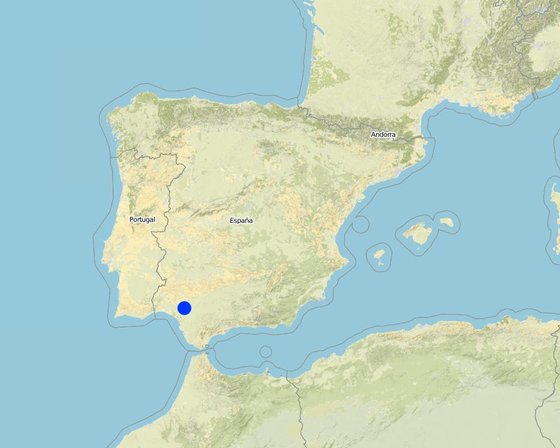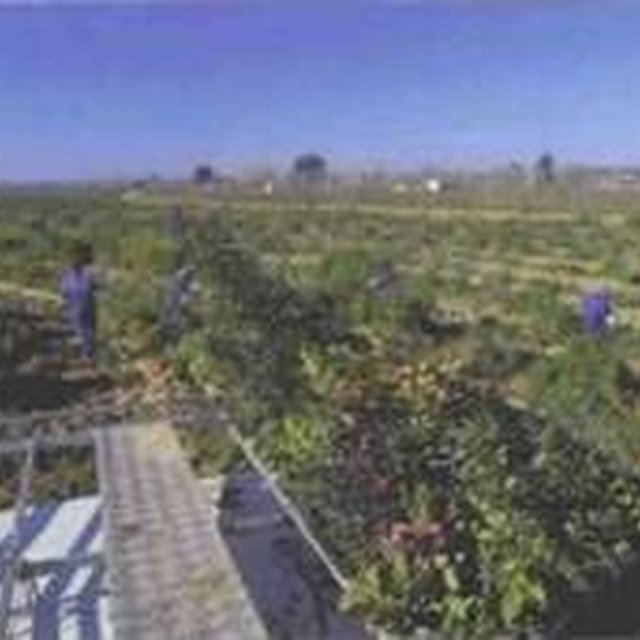Caso de estudio del Guadiamar
(Spain)
Description
Medidas de recuperación del suelo y revegetación desarrolladas en 1999-2000 para reducir la movilidad de los elementos traza del suelo.
Recuperar el área afectada por la contaminación minera.
Retirada de lodos, aplicación de enmiendas, gradeo y revegetación. Expropiación de terrenos afectados y protección del área como espacio natural.
(1) Limpieza de emergencia/retirada de lodos
(2) Aplicación de enmiendas
(3) Expropiación de terrenos afectados
(4) Revegetación de la zona
(5) Declaración de paisaje protegido
La administración regional fue la encargada de limpiar la zona, reforestar, expropiar los terrenos. Actualmente es la encargada de mantener y gestionar el área. Los usuarios de la tierra realizan un uso recreativo de la zona y de pastoreo extensivo.
Location

Location: Corredor verde del Guadiamar , Sevilla , Spain
Geo-reference of selected sites
Initiation date: 1999
Year of termination: 2000
Type of Approach
-
traditional/ indigenous
-
recent local initiative/ innovative
-
project/ programme based

Trabajos de restauración vegetal (Patxi Serveto)
Approach aims and enabling environment
Main aims / objectives of the approach
Recuperar el área afectada por la contaminación minera.
Problemas: El principal problema fue la contaminación, y la alarma social generada.
Conditions enabling the implementation of the Technology/ ies applied under the Approach
-
Legal framework (land tenure, land and water use rights): The existing land ownership, land use rights / water rights greatly helped the approach implementation: El que la tierra fuese privada dificultaba la aplicación de enmiendas, por lo que la zona fue expropiada a sus propietarios, creando así el Corredor Verde.
Conditions hindering the implementation of the Technology/ ies applied under the Approach
-
Social/ cultural/ religious norms and values: No se podía actual de forma rápida y general, en tierras privadas.
Tratamiento: Se expropiaron las tierras contaminadas.
-
Availability/ access to financial resources and services: Las medidas de limpieza, recuperación y reforestación fueron muy costosas.
Tratamiento: La administración mantiene un pleito con la empresa responsable del vertido para que se haga cargo de los costos.
-
Institutional setting: Diferencias entre la administración local, regional y central.
Tratamiento: Coordinación entre administraciones.
-
Legal framework (land tenure, land and water use rights): Riesgo de intoxicación por alimentos contaminados.
Tratamiento: Prohibición de toda actividad agrícola, ganadera, caza y pesca.
-
Knowledge about SLM, access to technical support: Falta de precedentes y protocolos de actuación ante accidentes similares.
Tratamiento: Se crearon nuevos protocolos de actuación. Se crearon grupos de expertos para asesorar.
-
Workload, availability of manpower: Zona muy extensa, heterogénea y urgencia en la actuación
Tratamiento: Organización, se dividió el área en tres zonas, asumiendo la responsabilidad distintas entidades. Movilización de personal laboral para participar en las labores de limpieza.
Participation and roles of stakeholders involved
Stakeholders involved in the Approach and their roles
| What stakeholders / implementing bodies were involved in the Approach? |
Specify stakeholders |
Describe roles of stakeholders |
| local land users/ local communities |
|
|
| community-based organizations |
|
|
Involvement of local land users/ local communities in the different phases of the Approach
none
passive
external support
interactive
self-mobilization
Decision-making on the selection of SLM Technology
Decisions were taken by
-
land users alone (self-initiative)
-
mainly land users, supported by SLM specialists
-
all relevant actors, as part of a participatory approach
-
mainly SLM specialists, following consultation with land users
-
SLM specialists alone
-
politicians/ leaders
Decisions were made based on
-
evaluation of well-documented SLM knowledge (evidence-based decision-making)
-
research findings
-
personal experience and opinions (undocumented)
Technical support, capacity building, and knowledge management
The following activities or services have been part of the approach
-
Capacity building/ training
-
Advisory service
-
Institution strengthening (organizational development)
-
Monitoring and evaluation
-
Research
Capacity building/ training
Training was provided to the following stakeholders
-
land users
-
field staff/ advisers
-
investigación
Form of training
-
on-the-job
-
farmer-to-farmer
-
demonstration areas
-
public meetings
-
courses
Subjects covered
Concienciación y divulgación sobre los efectos de los contaminantes.
Advisory service
Advisory service was provided
-
on land users' fields
-
at permanent centres
Asistencias técnicas con centros de investigación: Moderadamente adecuado. Es el gobierno local el que ha liderado todo el proceso y por tanto está capacitado para asegurar la continuidad.
Institution strengthening
Institutions have been strengthened / established
-
no
-
yes, a little
-
yes, moderately
-
yes, greatly
Describe institution, roles and responsibilities, members, etc.
Type of support
-
financial
-
capacity building/ training
-
equipment
Further details
Monitoring and evaluation
Research
Research treated the following topics
-
sociology
-
economics / marketing
-
ecology
-
technology
Consejo Superior de Investigaciones Científicas, Universidades.
Financing and external material support
Annual budget in USD for the SLM component
-
< 2,000
-
2,000-10,000
-
10,000-100,000
-
100,000-1,000,000
-
> 1,000,000
Precise annual budget: n.a.
Gobierno nacional (Plan especial del Gobierno central): 20.0%; Gobierno local (distrito, provincia,municipalidad, aldea etc) (Junta de Andalucía): 80.0%
The following services or incentives have been provided to land users
-
Financial/ material support provided to land users
-
Subsidies for specific inputs
-
Credit
-
Other incentives or instruments
Impact analysis and concluding statements
Impacts of the Approach
No
Yes, little
Yes, moderately
Yes, greatly
Did the Approach help land users to implement and maintain SLM Technologies?
El enfoque ha ayudado a la administración regional a mejorar el manejo sostenible de la zona recuperada.
Did the Approach empower socially and economically disadvantaged groups?
La mejora es para los usuarios de la tierra en general, independientemente de su nivel económico.
Did the Approach improve issues of land tenure/ user rights that hindered implementation of SLM Technologies?
La zona fue expropiada.
Did other land users / projects adopt the Approach?
Main motivation of land users to implement SLM
-
increased production
-
increased profit(ability), improved cost-benefit-ratio
-
reduced land degradation
-
reduced risk of disasters
-
reduced workload
-
payments/ subsidies
-
rules and regulations (fines)/ enforcement
-
prestige, social pressure/ social cohesion
-
affiliation to movement/ project/ group/ networks
-
environmental consciousness
-
customs and beliefs, morals
-
enhanced SLM knowledge and skills
-
aesthetic improvement
-
conflict mitigation
Sustainability of Approach activities
Can the land users sustain what hat been implemented through the Approach (without external support)?
La zona está convertida en un paisaje protegido, que requiere un mantenimiento mínimo.
Conclusions and lessons learnt
Strengths: land user's view
Strengths: compiler’s or other key resource person’s view
-
Se ha conseguido una recuperación efectiva de una zona contaminada. (How to sustain/ enhance this strength: Realizar monitorizaciones para comprobar si son necesarias nuevas intervenciones.)
Weaknesses/ disadvantages/ risks: land user's viewhow to overcome
Weaknesses/ disadvantages/ risks: compiler’s or other key resource person’s viewhow to overcome
-
El método utilizado no elimina al 100% la contaminación, si no que estabiliza los contaminantes.
No es posible superarlo, puesto que sacar los elementos traza del suelo es imposible sin alterar sus propiedades.
References
Compiler
-
José Miguel Pérez-Álvarez
Date of documentation: July 13, 2015
Last update: Aug. 23, 2017
Resource persons
-
María Anaya-Romero (m.anaya@evenor-tech.com) - SLM specialist
-
Paula Madejón (pmadejon@irnase.csic.es) - SLM specialist
-
María T. Dominguez (maitedn@irnase.csic.es) - SLM specialist
-
José Manuel Murillo (murillo@irnase.csic.es) - SLM specialist
-
Teodoro Marañón Arana - SLM specialist
-
Francisco Cabrera Capitán - SLM specialist
Full description in the WOCAT database
Documentation was faciliated by
Institution
- IRNAS-CSIC (IRNAS-CSIC) - Spain
Project
- Preventing and Remediating degradation of soils in Europe through Land Care (EU-RECARE )
Key references
-
Xiong, J., Madejon, P., Madejon, E., Cabrera, F. Assisted natural remediation of a trace element-contaminated acid soil: An eight-year field study (2015) Pedosphere, 25 (2), pp. 250-262. DOI: 10.1016/S1002-0160(15)60010-8:
-
Burgos, P., Madejón, P., Madejón, E., Girón, I., Cabrera, F., Murillo, J.M. Natural remediation of an unremediated soil twelve years after a mine accident: Trace element mobility and plant composition (2013) Journal of Environmental Management, 114, pp. 36-45. DOI: 10.1016/j.jenvman.2012.10.060:
-
Pérez-De-Mora, A., Madejón, P., Burgos, P., Cabrera, F., Lepp, N.W., Madejón, E. Phytostabilization of semiarid soils residually contaminated with trace elements using by-products: Sustainability and risks (2011) Environmental Pollution, 159 (10), pp. 3018-3027. DOI: 10.1016/j.envpol.2011.04.015: Internet
-
Domínguez, M.T., Madejón, P., Marañón, T., Murillo, J.M. Afforestation of a trace-element polluted area in SW Spain: Woody plant performance and trace element accumulation (2010) European Journal of Forest Research, 129 (1), pp. 47-59.DOI: 10.1007/s10342-008-0253-3: Internet
-
Madejón, P., Pérez-de-Mora, A., Burgos, P., Cabrera, F., Lepp, N.W., Madejón, E. Do amended, polluted soils require re-treatment for sustainable risk reduction? - Evidence from field experiments. (2010) Geoderma, 159 (1-2), pp. 174-181. DOI: 10.1016/j.geoderma.2010.07.009: Internet
-
Madejón, E., Madejón, P., Burgos, P., Pérez de Mora, A., Cabrera, F. Trace elements, pH and organic matter evolution in contaminated soils under assisted natural remediation: A 4-year field study (2009) Journal of Hazardous Materials, 162 (2-3), pp. 931-938. DOI: 10.1016/j.jhazmat.2008.05.119: Internet
-
Domínguez, M.T., Marañón, T., Murillo, J.M., Schulin, R., Robinson, B.H. Trace element accumulation in woody plants of the Guadiamar Valley, SW Spain: A large-scale phytomanagement case study (2008) Environmental Pollution, 152 (1), pp. 50-59. DOI: 10.1016/j.envpol.2007.05.021: Internet
-
Pérez-de-Mora, A., Madrid, F., Cabrera, F., Madejón, E. Amendments and plant cover influence on trace element pools in a contaminated soil (2007) Geoderma, 139 (1-2), pp. 1-10. Cited 35 times. DOI: 10.1016/j.geoderma.2006.12.001: Internet





